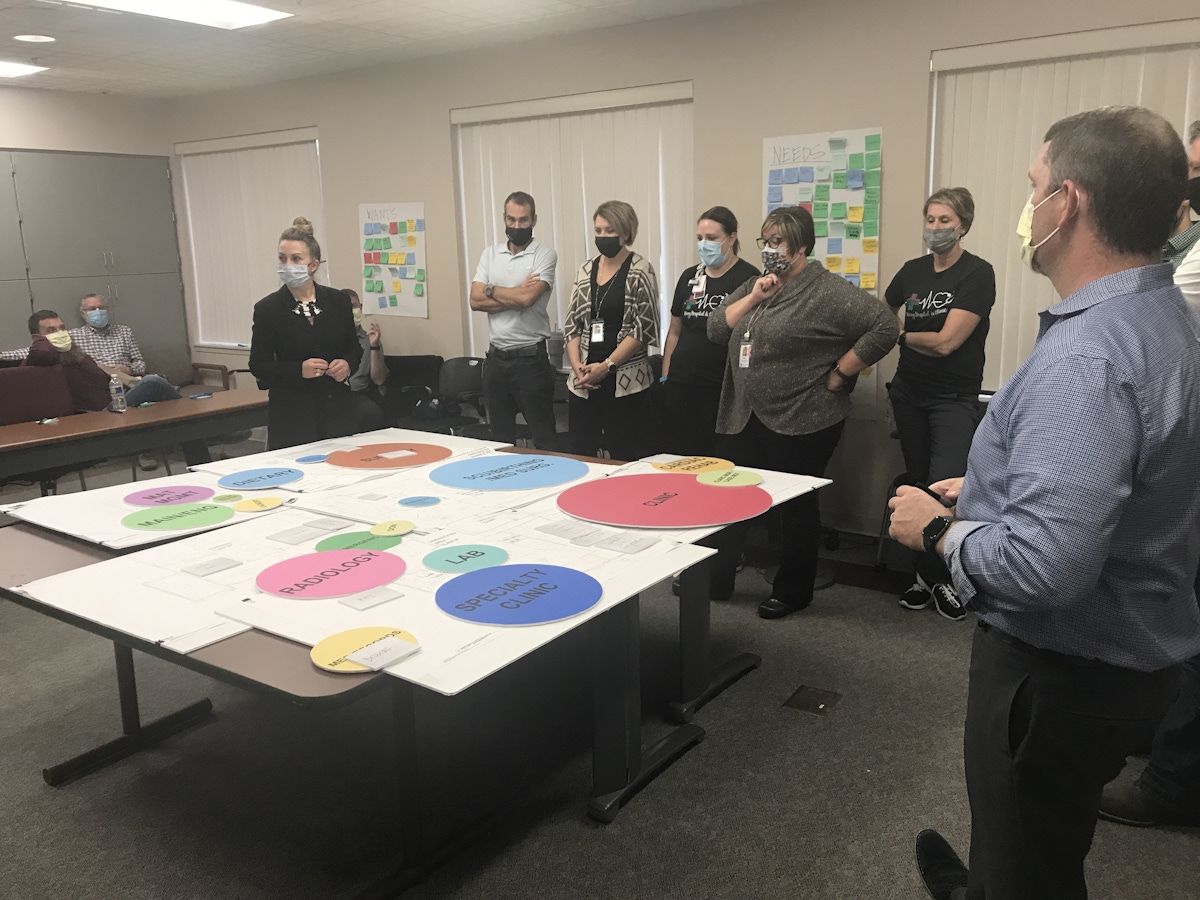
Hospitals, clinics and other healthcare facilities require complex workflows that involve multiple groups of people, including physicians, staff, patients and families. Quality healthcare design improves safety, service to patients and workflow continuity. When not properly planned, substandard designs lead to inefficient flow, poor infection control, overloaded pathways, deficient exam rooms and unhappy providers and patients. One technique to design successful healthcare facilities with effective workflows is leveraging Lean 3P (production, preparation and process), a practice developed by Toyota to create the most efficient outcome by eliminating waste.
Architects use Lean 3P events to develop everything from parking ramps to pediatric oncology centers. This method also ensures buy-in from all stakeholders while creating the most efficient plan. Furthermore, if done properly, Lean 3P can shorten the design time process, which in turn allows for revenue to be generated more quickly for each facility. Read on to learn more about Lean 3P, its benefits to healthcare facilities and how it can add value to your community.
Lean 3P is a workshopping event where designers gather input and lead a stakeholder group to develop successful processes that mitigate waste. These events can last anywhere from a few hours to a few days.
The Lean 3P workshop engages parties in a series of design iterations. Through the Lean 3P process, architects work with all stakeholders. This eliminates the need to continuously return to the drawing board after implementing a design and realizing it is not optimized for patients or providers. The design team and other stakeholders meet to determine visions and goals for the facility. In the following hours/days, the team develops a plan in small groups and reconvenes to discuss the pluses (what is working) and deltas (areas of improvement) of each. Through these iterations, a schematic plan comes to fruition. 3D modeling is used to test spaces and full-scale 3D prototype mock-ups simulate facility workflows. Input is gathered and modifications are made to develop the final plan.
Lean 3P is especially successful because it adds more voices to the conversation. Often, facility leaders form a core planning team and are the only people consulted during the design process. While these leaders play important roles, they typically aren’t as involved in the building’s daily functioning as facility staff. The Lean 3P process includes all key stakeholders in the design process. By focusing on both the needs of healthcare professionals and the needs of patients, designers can develop the best workflows for each facility.


First and foremost, the intended outcome of Lean 3P is to identify and reduce waste in every step of a process. Waste includes money, time, and physical resources. By creating designs that eliminate waste, resources are conserved, and revenue is heightened.
The efficiencies Lean 3P creates are twofold. Lean 3P allows the design team to move more quickly through pre-design into schematic design as design decisions are made without the need for isolated meetings. Lean 3P events also improve outcomes once the facility is in use. The feedback gathered in the prototyping and simulation stages allows the team to develop and test processes prior to project completion.
By eliminating unnecessary waste and creating efficiencies, Lean 3P events can help healthcare facilities save financial resources. Lean 3P designs can reduce long and costly development cycles, overruns on product target costs, excess materials management costs, and more.
It is more important than ever to create spaces based on community members’ needs. Moreover, community decision-making, as exercised in Lean 3P, leads to community buy-in. By involving those who will use and work in the facility, designers successfully create spaces that best serve the needs of each community.


Lean 3P works best if all stakeholders are included in the process. Leadership, designers, contractors, facilities, physicians, staff, infection control, environmental services, patients and community members are all great people to engage. Each facility must decide how much they want to invest in their people. Typically, this investment pays dividends as the planning is completed faster and construction moves faster, which drives revenue more quickly. In the end, there are less complaints to allow leaders to focus on offense vs. defense.
Lean 3P can be completed on a variety of timelines. The right schedule may depend on available resources, project complexity and the amount of people involved. Some designers prefer to complete the entire process within a few hours to a week, while others find that working through the steps for a few days, taking a break, and completing the rest with a fresh set of eyes a week or two later is a better approach. Determining the optimal timeline for the project and team produces the best outcomes.
One of the key elements of successful Lean 3P events is key stakeholder engagement from all aspects of the facility. Embrace diversity and ensure an inclusive environment through community engagement, including creating surveys in multiple languages or bringing a translator to Lean 3P events. Set goals with the entire team and follow them throughout the process. When members of a diverse population feel equally heard and represented, they are more likely to participate and actively communicate their needs within the Lean 3P process.
The true value of Lean 3P is getting full stakeholder buy-in. With the larger group engaged, discussions and decisions are made with first-hand information. Each participant understands why decisions are made and are part of the final decision. Long term, Lean 3P provides a very successful outcome with little to no complaints of why something “just doesn’t work.” This allows leadership to feel confident in the decisions made through a collaborative process.
If you’d like additional information about our Lean 3P experience, please contact our team at Wold Architects and Engineers by calling 1-888-254-6789 or emailing info@woldae.com. Our multidisciplinary team of professionals would welcome the opportunity to help assess your needs and develop the best solutions to meet them.